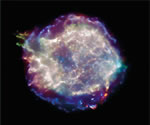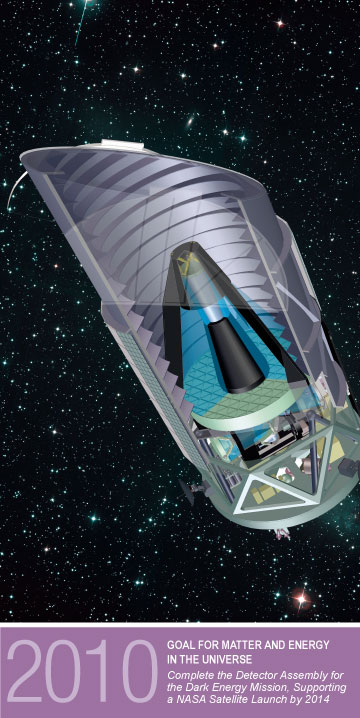
Exploring Matter and Energy in the Universe
Can We Coax the Cosmos to Reveal its Secrets?

Entering the 21st century, we have discovered that we don’t know what 95 percent of our universe is made of. The urge to find out is rooted in the human longing to understand where we come from and where we’re going. Knowledge may have practical implications, too, yet we can no more guess at these than could Einstein when he proposed, just 100 years ago, that matter and energy are equivalent and mediated by the speed of light. Dark matter and dark energy are real, but facts are few.
Right: SNAP, the SuperNova/Acceleration Probe, a satellite observatory, will greatly advance our understanding of cosmic acceleration and the fundamental new physics it implies. SNAP will study thousands of high redshift supernovae, each with unprecedented precision, using a 2-meter telescope and a unique half-billion-pixel camera. The supernovae are cosmic markers of the scale of the universe over time, and will be used to construct a history of the universe's growth.
Berkeley Lab researchers are no strangers to studies of the cosmos. Physicists here pioneered the measurement of minute temperature differences in the cosmic microwave background radiation, and it was here that the Supernova Cosmology Project developed methods for measuring the expansion of the universe with distant supernovae, leading directly to the discovery of accelerating expansion and the existence of dark energy.
While the questions may be cosmic, the answers are intertwined with our understanding at the highest energy and smallest length scales. In the tradition of Ernest Lawrence, teams of Berkeley Lab scientists and engineers, through collaborations with many institutions in many nations, are leaders in the design of novel accelerator systems and detectors worldwide. Their contributions are crucial to the ATLAS detector at the Large Hadron Collider at CERN. Digital Optical Modules devised here are being sunk in the South Polar ice for the IceCube neutrino telescope. The GRETINA detector and the VENUS superconducting heavy ion source created here are prototype components for a potential Rare Isotope Accelerator; farther in the future will come detectors and damping rings for the International Linear Collider. Electron beams accelerated by laser-driven wakefields through plasma channels have demonstrated a new principle of “tabletop” acceleration.
